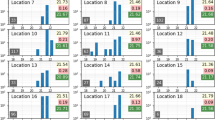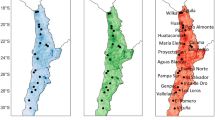Abstract
Excessive exposure to solar ultraviolet (UV) is the main cause of skin cancer. Specific prevention should be further developed to target overexposed or highly vulnerable populations. A better characterisation of anatomical UV exposure patterns is however needed for specific prevention. To develop a regression model for predicting the UV exposure ratio (ER, ratio between the anatomical dose and the corresponding ground level dose) for each body site without requiring individual measurements. A 3D numeric model (SimUVEx) was used to compute ER for various body sites and postures. A multiple fractional polynomial regression analysis was performed to identify predictors of ER. The regression model used simulation data and its performance was tested on an independent data set. Two input variables were sufficient to explain ER: the cosine of the maximal daily solar zenith angle and the fraction of the sky visible from the body site. The regression model was in good agreement with the simulated data ER (R2=0.988). Relative errors up to +20% and −10% were found in daily doses predictions, whereas an average relative error of only 2.4% (−0.03% to 5.4%) was found in yearly dose predictions. The regression model predicts accurately ER and UV doses on the basis of readily available data such as global UV erythemal irradiance measured at ground surface stations or inferred from satellite information. It renders the development of exposure data on a wide temporal and geographical scale possible and opens broad perspectives for epidemiological studies and skin cancer prevention.
This is a preview of subscription content, access via your institution
Access options
Subscribe to this journal
Receive 6 print issues and online access
$259.00 per year
only $43.17 per issue
Buy this article
- Purchase on Springer Link
- Instant access to full article PDF
Prices may be subject to local taxes which are calculated during checkout




Similar content being viewed by others
References
Lucas R . Solar Ultraviolet Radiation: Assessing the environmental burden of disease at national and local levels. WHO, World Health Organization: Geneva. 2010.
Sklar LR, Almutawa F, Lim HW, Hamzavi I . Effects of ultraviolet radiation, visible light, and infrared radiation on erythema and pigmentation: a review. Photochem Photobiol Sci 2013; 12: 54–64.
El Ghissassi F, Baan R, Straif K, Grosse Y, Secretan B, Bouvard V et al. A review of human carcinogens. Part D: radiation. Lancet Oncol 2009; 10 (8): 751–752.
Lucas RM, McMichael AJ, Armstrong BK, Smith WT . Estimating the global disease burden due to ultraviolet radiation exposure. Int J Epidemiol 2008; 37 (3): 654–667.
Armstrong BK, Kricker A . The epidemiology of UV induced skin cancer. J Photochem Photobiol B 2001; 63: 8–18.
Levi F, Te VC, Randimbison L, Erler G, La Vecchia C . Trends in skin cancer incidence in Vaud: an update, 1976-1998. Eur J Cancer Prevention 2001; 10: 371–373.
Schmitt J, Seidler A, Diepgen TL, Bauer A . Occupational ultraviolet light exposure increases the risk for the development of cutaneous squamous cell carcinoma: a systematic review and meta-analysis. Br J Dermatol 2011; 164: 291–307.
Elwood JM, Jopson J . Melanoma and sun exposure: an overview of published studies. Int J Cancer 1997; 73: 198–203.
Kricker A, Armstrong BK, English DR . Does intermittent sun exposure cause basal cell carcinoma? a case-control study in Western Australia. Int J Cancer 1995; 60: 489–494.
Bauer A, Diepgen TL, Schmitt J . Is occupational solar ultraviolet irradiation a relevant risk factor for basal cell carcinoma? A systematic review and meta-analysis of the epidemiological literature. Br J Dermatol 2011; 165: 612–625.
Erdmann F, Lortet-Tieulent J, Schüz J, Zeeb H, Greinert R, Breitbart EW et al. International trends in the incidence of malignant melanoma 1953–2008—are recent generations at higher or lower risk? Int J Cancer 2013; 132: 385–400.
Bulliard JL, Panizzon RG, Levi F . Epidemiology of epithelial skin cancers. Rev Med Suisse 2009; 5: 882–888.
Hill D, White V, Marks R, Theobald T, Borland R, Roy C . Melanoma prevention: behavioral and nonbehavioral factors in sunburn among an Australian urban population. Preventive Medicine 1992; 21: 654–669.
Autier P, Boniol M, Doré J-F . Sunscreen use and increased duration of intentional sun exposure: Still a burning issue. Int J Cancer 2007; 121: 1–5.
Parisi AV, Kimlin MG, Lester R, Turnbull D . Lower body anatomical distribution of solar ultraviolet radiation on the human form in standing and sitting postures. J Photochem Photobiol B 2003; 69: 1–6.
Parisi AV, Kimlin MG, Wong JC, Fleming RA . The effects of body size and orientation on ultraviolet radiation exposure. Photodermatol Photoimmunol Photomed 1996; 12: 66–72.
Wright C, Diab R, Martincigh B . Anatomical distribution of ultraviolet solar radiation. South Afr J Sci 2004; 100: 498–500.
Rosenthal FSW, Sheila K, Munoz B, Emmett EA, Strickland PT, Taylor HR . Ocular and facial skin eeposure to ultraviolet radiation in sunlight: a personal exposure model with application to a worker population. Health Physics 1991; 61: 10.
Siani AM, Casale GR, Sisto R, Colosimo A, Lang CA, Kimlin MG . Occupational Exposures to Solar Ultraviolet Radiation of Vineyard Workers in Tuscany (Italy). Photochem Photobiol 2011; 87: 925–934.
Gies P, Wright J . Measured solar ultraviolet radiation exposures of outdoor workers in Queensland in the building and construction industry. Photochem Photobiol 2003; 78: 342–348.
Milon A, Sottas PE, Bulliard JL, Vernez D . Effective exposure to solar UV in building workers: influence of local and individual factors. J Exp Sci Environ Epidemiol 2007; 17: 58–68.
Siani AM, Casale GR, Diemoz H, Agnesod G, Kimlin MG, Lang CA et al. Personal UV exposure in high albedo alpine sites. Atmos Chem Phys 2008; 8: 3749–3760.
Downs N, Parisi A . Measurements of the anatomical distribution of erythemal ultraviolet: a study comparing exposure distribution to the site incidence of solar keratoses, basal cell carcinoma and squamous cell carcinoma. Photochem Photobiol Sci 2009; 8: 1195–1201.
Vernez D, Milon A, Francioli L, Bulliard JL, Vuilleumier L, Moccozet L . A numeric model to simulate solar individual ultraviolet exposure. Photochem Photobiol 2011; 87: 721–728.
Ohmura A, Gilgam H, Hegmer H, Muller G, Wild M, Dutton G et al. Baseline Surface Radiation Network (BSRN): new precision radiometry for climate research. Bull Am Meteorol Soc 1998; 79: 2115–2136.
Hülsen G, Gröbner J . Characterization and calibration of ultraviolet broadband radiometers measuring erythemally weighted irradiance. Appl Opt 2007; 46: 5877–5886.
Erythema Reference Action Spectrum and Standard Erythema Dose. CIECommission Internationale de l’Eclairage. CIE Central Bureau: Vienna, Austria. 1998.
Webb AR, Slaper H, Koepke P, Schmalwieser AW . Know Your Standard: Clarifying the CIE Erythema Action Spectrum. Photochem Photobiol 2011; 87: 483–486.
Wright C, Ncongwane G. C . K. Ambient solar UV radiation and seasonal trends in potential sunburn risk among schoolchildren in South Africa. South Afr J Child Health 2011; 5: 35–38.
Moehrle M, Korn M, Garbe C . Bacillus subtilis spore film dosimeters in personal dosimetry for occupational solar ultraviolet exposure. Int Arch Occup Environ Health 2000; 73: 575–580.
Furusawa Y, Quintern LE, Holtschmidt H, Koepke P, Saito M . Determination of erythema-effective solar radiation in Japan and Germany with a spore monolayer film optimised for the detection of UVB and UVA—results of a field campaign. Appl Microbiol Biotechnol 1998; 50: 597–603.
Casale GR, Siani AM, Diémoz H, Kimlin MG, Colosimo A . Applicability of the polysulphone horizontal calibration to differently inclined dosimeters. Photochem Photobiol 2012; 88: 207–214.
Schouten PW, Parisi AV, Turnbull DJ . Usage of the polyphenylene oxide dosimeter to measure annual solar erythemal exposures. Photochem Photobiol 2010; 86: 706–710.
Renaud A, Staehelin J, Frohlich C, Philipona R, Heimo A . Influence of snow and clouds on erythemal UV radiation : Analysis of Swiss measurements and comparison with models. American Geophysical Union: Washington, DC, ETATS-UNIS. 2000.
Philipona R, Schilling A, Schmucki D . Albedo-enhanced maximum UV irradiance—measured on surfaces oriented normal to the sun. Photochem Photobiol 2001; 73: 366–369.
Schmalwieser AW, Cabaj A, Schauberger G, Rohn H, Maier B, Maier H . Facial solar UV exposure of Austrian farmers during occupation. Photochem Photobiol 2010; 86: 1404–1413.
Bigelow DS, Slusser JR, Beaubien AF, Gibson JH . The USDA Ultraviolet Radiation Monitoring Program. Bull Am Meteorol Soc 1998; 79: 601–615.
Koepke P, Backer HD, Bais A, Curylo A, Eerme K, Feister U et al. Modelling solar UV radiation in the past: comparison of algorithms and input data. In: Slusser JR, Schäfer K, Comerón A (eds). Remote Sensing of Clouds and the Atmosphere XI. SPI, Stockholm, Swedan. 2006 6362.
van Weele M, van der A R, J., v, Geffen J, Roebeling R . Space-based surface UV monitoring for Europe using SCIAMACHY and MSG. SPIE 5979, Remote Sensing of Clouds and the Atmosphere X; 2005. Bruges, Belgium: SPIE. 2005 p 59791K-K–59798KK.
Acknowledgements
This research was supported by the French Agency for Food, Environmental and Occupational Health & Safety (ANSES, Grant EST-2011/1/075). We thank Dr. Pascal Wild for his help in statistical analysis.
Author information
Authors and Affiliations
Corresponding author
Ethics declarations
Competing interests
The authors declare no conflict of interest.
Additional information
Supplementary Information accompanies the paper on the Journal of Exposure Science and Environmental Epidemiology website
Supplementary information
Rights and permissions
About this article
Cite this article
Vernez, D., Milon, A., Vuilleumier, L. et al. A general model to predict individual exposure to solar UV by using ambient irradiance data. J Expo Sci Environ Epidemiol 25, 113–118 (2015). https://doi.org/10.1038/jes.2014.6
Received:
Revised:
Accepted:
Published:
Issue Date:
DOI: https://doi.org/10.1038/jes.2014.6
Keywords
This article is cited by
-
Novel approach to analysing large data sets of personal sun exposure measurements
Journal of Exposure Science & Environmental Epidemiology (2016)
-
Fast calculations of the spectral diffuse-to-global ratios for approximating spectral irradiance at the street canyon level
Theoretical and Applied Climatology (2016)



